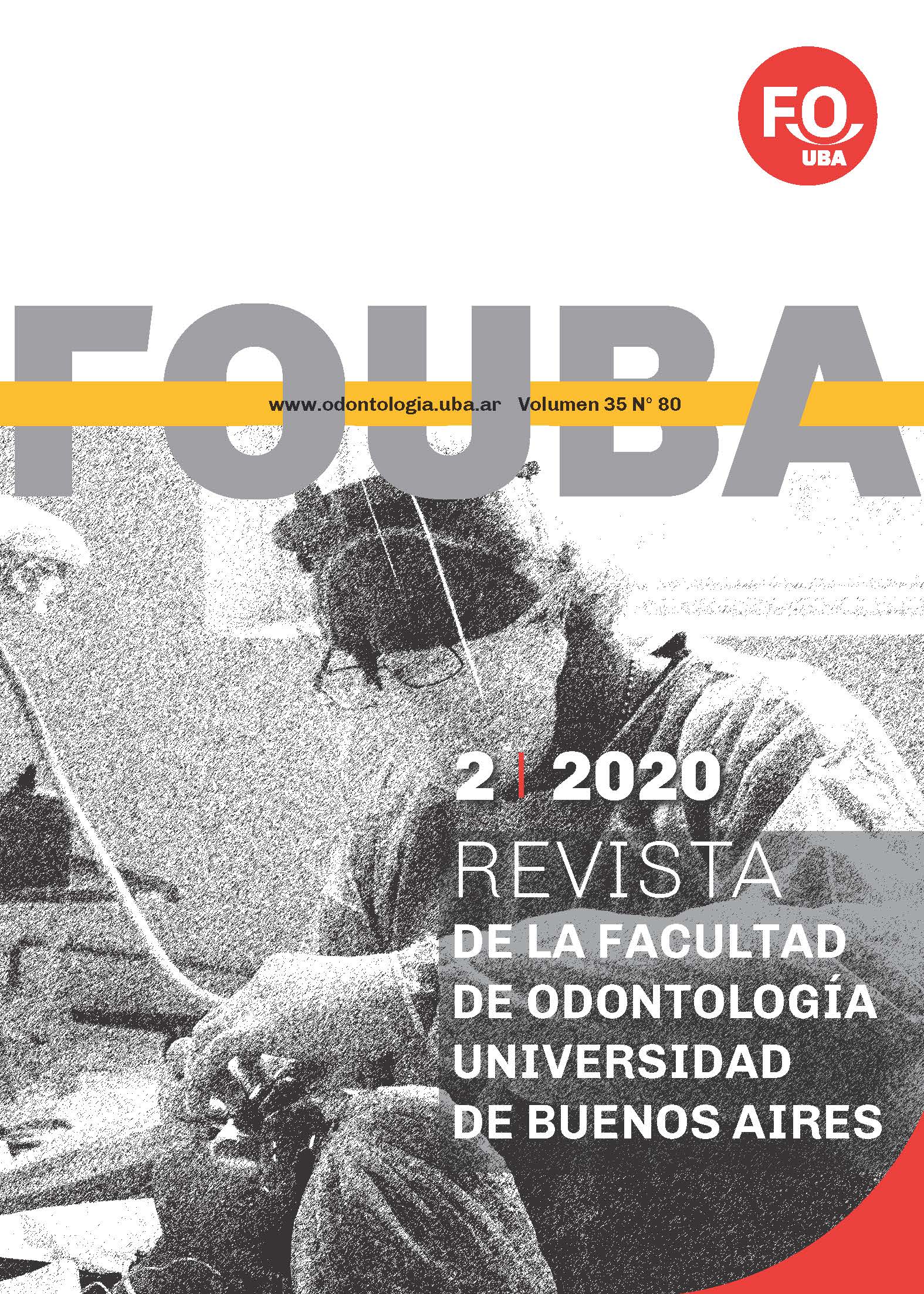Tratamiento Endodóntico en Incisivos con Gran Lesión Periapical Post Traumatismo.
Caso Clínico.
Palabras clave:
retratamiento endodóntico, lesión periapical, fístula activa, tratamiento no quirúrgico, traumatismo dentalResumen
El éxito a largo plazo del tratamiento endodóntico depende principalmente de una correcta limpieza y conformación del sistema de conductos radiculares para favorecer una adecuada obturación. Este artículo tiene como objetivo el reporte de un caso clínico de una paciente de 22 años, que concurre al servicio de la Cátedra de Endodoncia de la Facultad de Odontología de la Universidad de Buenos Aires presentando sus incisivos, central y lateral, superiores sin lesión de caries, fístula activa y una imagen radiográfica radiolúcida apical asociada a dichas piezas dentarias. A la anamnesis, la paciente refiere haber sufrido un traumatismo en el sector anterosuperior dos años antes a la fecha de consulta.
Citas
Andreasen JO, Bakland LK, Flores MT, Andreasen FM y Andersson L. (2011). Traumatic dental injuries: a manual. (3rd ed.). Wiley-Blackwell.
Bender IB y Seltzer S. (1961). Roentgenographic and direct observation of experimental lesions in bone II. J Am Dent Assoc, 62(6), 708–716. https://doi.org/10.14219/jada.archive.1961.0127
Fernandes M y de Ataide I. (2010). Nonsurgical management of periapical lesions. J Conserv Dent, 13(4), 240–245. https://doi.org/10.4103/0972-0707.73384
Lin LM, Huang GT y Rosenberg PA. (2007). Proliferation of epithelial cell rests, formation of apical cysts, and regression of apical cysts after periapical wound healing. J Endod, 33(8), 908–916. https://doi.org/10.1016/j.joen.2007.02.006
Lin LM, Ricucci D, Lin J y Rosenberg PA. (2009). Nonsurgical root canal therapy of large cyst-like inflammatory periapical lesions and inflammatory apical cysts. J Endod, 35(5), 607–615. https://doi.org/10.1016/j.joen.2009.02.012
Nair PNR. (1997). Apical periodontitis: a dynamic encounter between root canal infection and host response. Periodontol 2000, 13(1), 121–148. https://doi.org/10.1111/j.1600-0757.1997.tb00098.x
Nair PNR. (2004). Pathogenesis of apical periodontitis and the causes of endodontic failures. Crit Rev Oral Biol Med, 15(6), 348–381. https://doi.org/10.1177/154411130401500604
Rahbaran S, Gilthorpe MS, Harrison SD y Gulabivala K. (2001). Comparison of clinical outcome of periapical surgery in endodontic and oral surgery units of a teaching dental hospital: a retrospective study. Oral Surg Oral Med Oral Pathol Oral Radiol Endod, 91(6), 700–709. https://doi.org/10.1067/moe.2001.114828
Robertson A. (1998). A retrospective evaluation of patients with uncomplicated crown fractures and luxation injuries. Endod Dent Traumatol, 14(6), 245–256. https://doi.org/10.1111/j.1600-9657.1998. tb00848.x
Rotstein I y Simon JH. (2004). Diagnosis, prognosis and decision-making in the treatment of combined periodontal-endodontic lesions. Periodontol 2000, 34(1), 165–203. https://doi.org/10.1046/j.0906-6713.2003.003431.x
Siqueira JF Jr y Rôças IN. (2008). Clinical implications and microbiology of bacterial persistence after treatment procedures. J Endod, 34(11), 1291–1301. https://doi.org/10.1016/j.joen.2008.07.028
Tavares PB, Bonte E, Boukpessi T, Siqueira JF Jr y Lasfargues JJ. (2009). Prevalence of apical periodontitis in root canal-treated teeth from an urban French population: influence of the quality of root canal fillings and coronal restorations. J Endod, 35(6), 810–813. https://doi.org/10.1016/j.joen.2009.03.048
Publicado
Cómo citar
Número
Sección
Licencia

Esta obra está bajo una licencia internacional Creative Commons Atribución-NoComercial-SinDerivadas 4.0.











